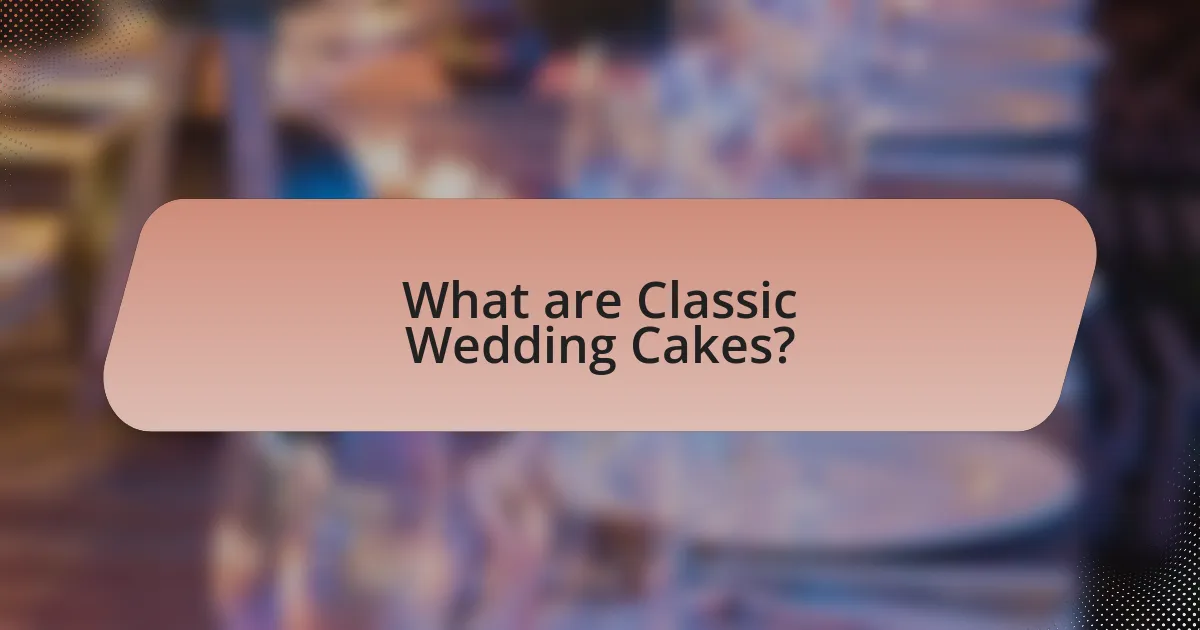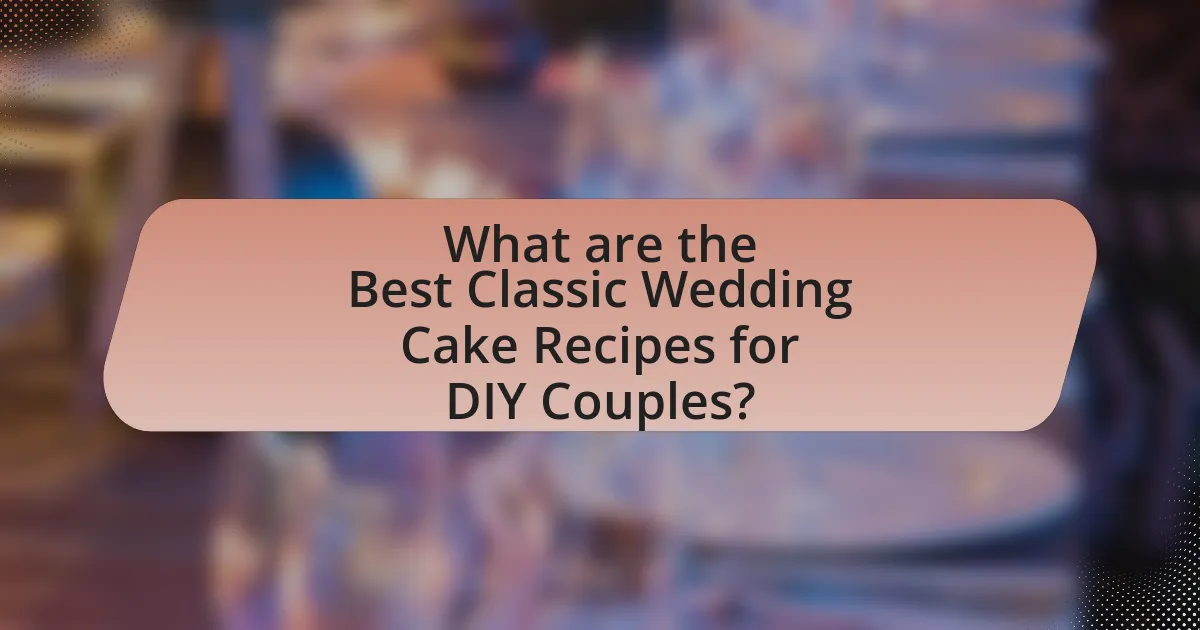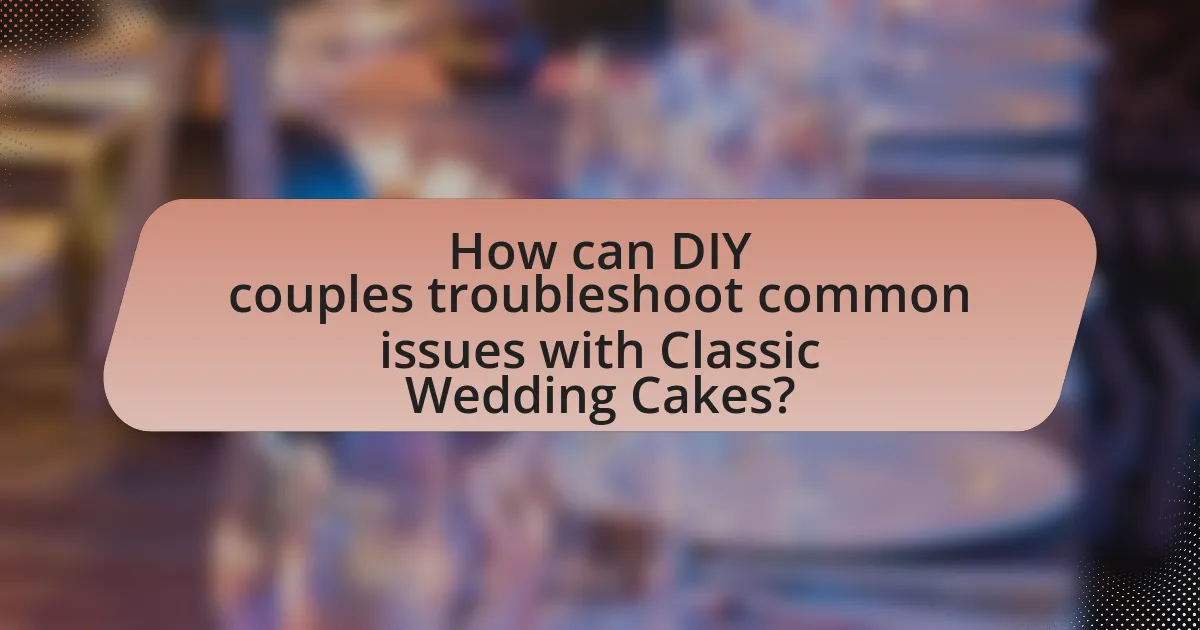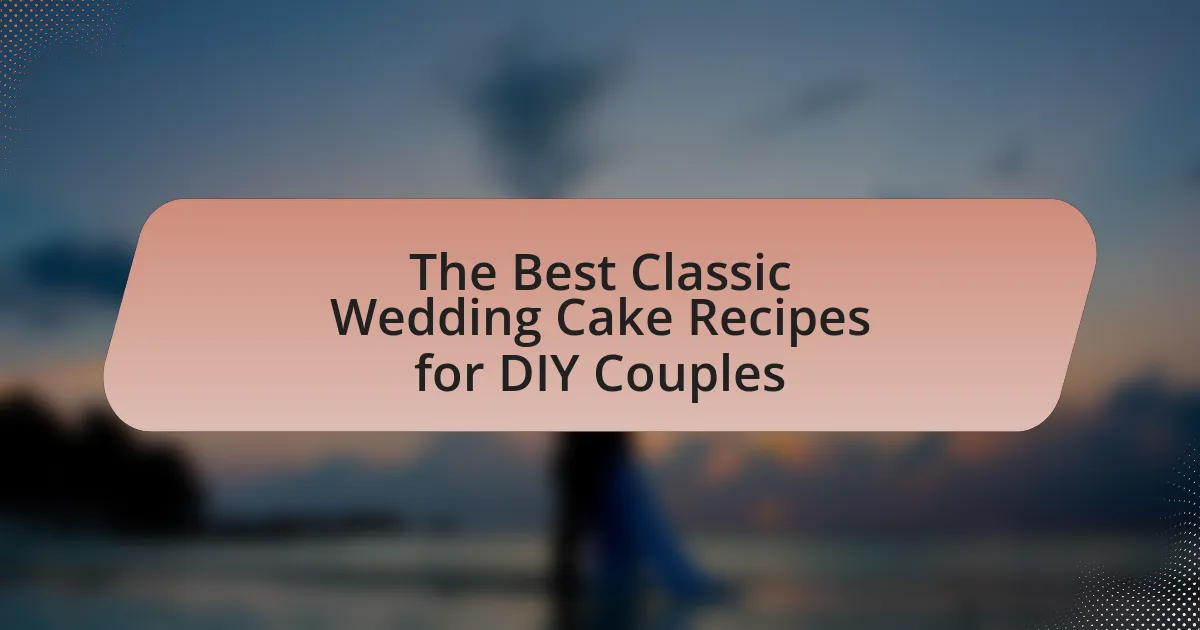Classic wedding cakes are traditional multi-tiered cakes that serve as the centerpiece of wedding receptions, characterized by elegant designs and flavors such as vanilla, chocolate, and fruit. This article explores the differences between classic wedding cakes and other cakes, highlighting traditional flavors, typical designs, and the popularity of DIY approaches among couples. It provides insights into the advantages of making these cakes at home, including cost savings and personalization options, while also offering practical tips for baking, decorating, and troubleshooting common issues. Additionally, the article features popular recipes and essential techniques for creating a successful classic wedding cake, ensuring that DIY couples can achieve a beautiful and memorable centerpiece for their special day.

What are Classic Wedding Cakes?
Classic wedding cakes are traditional multi-tiered cakes that serve as the centerpiece of a wedding reception. These cakes are typically characterized by their elegant designs, often featuring white or ivory frosting, and are commonly made from flavors such as vanilla, chocolate, or fruit. Historically, the concept of the wedding cake dates back to ancient Rome, where a wheat or barley cake was broken over the bride’s head for good fortune. The modern classic wedding cake has evolved to include intricate decorations, such as fondant, sugar flowers, and personalized cake toppers, reflecting the couple’s style and theme.
How do Classic Wedding Cakes differ from other cakes?
Classic wedding cakes differ from other cakes primarily in their design, flavor, and purpose. Wedding cakes are typically multi-tiered, elaborately decorated, and often feature traditional flavors like vanilla, almond, or fruitcake, which are chosen for their significance in wedding customs. In contrast, other cakes may vary widely in size, shape, and flavor, often reflecting personal preferences rather than ceremonial importance. Additionally, classic wedding cakes are often made to serve a large number of guests, emphasizing their role in a formal celebration, while other cakes may be designed for smaller gatherings or casual occasions.
What traditional flavors are commonly used in Classic Wedding Cakes?
Traditional flavors commonly used in Classic Wedding Cakes include vanilla, almond, lemon, and chocolate. Vanilla is the most popular flavor, often chosen for its classic taste and versatility, while almond adds a distinct nutty flavor that complements many fillings. Lemon provides a refreshing citrus note, and chocolate is favored for its rich, indulgent taste. These flavors have been staples in wedding cakes for generations, reflecting both tradition and the preferences of couples celebrating their special day.
What are the typical designs and decorations for Classic Wedding Cakes?
Classic wedding cakes typically feature multi-tiered designs, often ranging from two to five layers, with smooth fondant or buttercream icing. Common decorations include intricate piping, floral arrangements made from sugar or fresh flowers, and elegant embellishments like lace patterns or edible pearls. These elements are rooted in tradition, as classic wedding cakes have historically symbolized prosperity and fertility, with the white color representing purity. The use of tiered structures allows for a visually striking presentation, while the decorations enhance the cake’s aesthetic appeal, making it a focal point of the wedding celebration.
Why are Classic Wedding Cakes popular among DIY couples?
Classic Wedding Cakes are popular among DIY couples because they offer a timeless aesthetic and are often simpler to replicate than more elaborate designs. The traditional structure and flavors of classic cakes, such as vanilla or chocolate, provide a familiar base that many couples feel comfortable working with. Additionally, the straightforward recipes and techniques associated with classic wedding cakes make them accessible for those who wish to create a personal touch for their special day. The popularity is further supported by the fact that many DIY couples prioritize cost-effectiveness, and classic wedding cakes typically require fewer specialized ingredients and tools compared to more intricate cake designs.
What advantages do DIY couples gain from making their own Classic Wedding Cakes?
DIY couples gain several advantages from making their own Classic Wedding Cakes, including cost savings, personalization, and skill development. By baking their own cakes, couples can significantly reduce expenses associated with hiring a professional baker, as the average cost of a wedding cake can range from $300 to $700. Personalization allows couples to tailor flavors, designs, and ingredients to reflect their unique tastes and wedding themes, enhancing the overall experience. Additionally, the process of baking and decorating a cake together fosters teamwork and strengthens their relationship, while also providing an opportunity to learn valuable baking skills that can be used in the future.
How can DIY couples personalize their Classic Wedding Cakes?
DIY couples can personalize their Classic Wedding Cakes by incorporating unique flavors, custom decorations, and meaningful cake toppers. For instance, couples can choose flavors that reflect their personal tastes or cultural backgrounds, such as lemon, red velvet, or almond. Additionally, they can use fondant or buttercream to create custom designs that represent their wedding theme or personal interests, such as floral patterns or geometric shapes. Personalized cake toppers, like monograms or figurines that depict the couple’s hobbies, can further enhance the cake’s individuality. These methods allow couples to create a cake that is not only visually appealing but also deeply personal and reflective of their relationship.

What are the Best Classic Wedding Cake Recipes for DIY Couples?
The best classic wedding cake recipes for DIY couples include the traditional vanilla buttercream cake, rich chocolate cake, and the elegant red velvet cake. These recipes are favored for their timeless flavors and ease of preparation. The vanilla buttercream cake features a light and fluffy texture, making it a versatile base for various fillings and decorations. The rich chocolate cake offers a decadent option that pairs well with various frostings, while the red velvet cake is known for its striking color and unique taste, often complemented by cream cheese frosting. These recipes are popular among DIY couples due to their straightforward ingredients and methods, allowing for customization to suit personal preferences and wedding themes.
What are some popular recipes for Classic Wedding Cakes?
Some popular recipes for Classic Wedding Cakes include Vanilla Buttercream Cake, Chocolate Ganache Cake, and Red Velvet Cake. The Vanilla Buttercream Cake features a moist vanilla sponge layered with rich buttercream, making it a timeless choice for weddings. The Chocolate Ganache Cake consists of a decadent chocolate sponge paired with smooth ganache, appealing to chocolate lovers. Red Velvet Cake, known for its striking color and cream cheese frosting, adds a unique flair to wedding celebrations. These recipes are favored for their classic flavors and elegant presentation, making them ideal for DIY couples planning their weddings.
How do you make a traditional vanilla wedding cake?
To make a traditional vanilla wedding cake, start by creaming together unsalted butter and granulated sugar until light and fluffy. Then, add eggs one at a time, mixing well after each addition, followed by vanilla extract. In a separate bowl, combine all-purpose flour, baking powder, and salt. Gradually add the dry ingredients to the butter mixture, alternating with whole milk, and mix until just combined. Pour the batter into prepared cake pans and bake at 350°F (175°C) for 25-30 minutes or until a toothpick inserted in the center comes out clean. Allow the cakes to cool before frosting with vanilla buttercream. This method is widely used in classic wedding cake recipes, ensuring a moist and flavorful cake suitable for celebrations.
What ingredients are essential for a classic chocolate wedding cake?
The essential ingredients for a classic chocolate wedding cake include all-purpose flour, granulated sugar, unsweetened cocoa powder, baking powder, baking soda, salt, eggs, whole milk, vegetable oil, and vanilla extract. These ingredients work together to create a rich and moist cake, which is a hallmark of traditional chocolate wedding cakes. The combination of cocoa powder and sugar provides the chocolate flavor, while the eggs and milk contribute to the cake’s structure and moisture.
What tips can help DIY couples successfully bake Classic Wedding Cakes?
To successfully bake Classic Wedding Cakes, DIY couples should focus on precise measurements, quality ingredients, and proper baking techniques. Accurate measurements ensure consistent results, while using high-quality ingredients like fresh eggs and real butter enhances flavor and texture. Additionally, couples should preheat the oven and use the correct baking pans to achieve even baking. It’s also essential to allow cakes to cool completely before frosting to prevent melting. Following these tips can lead to a beautifully baked wedding cake that meets expectations.
How can you ensure the cake layers are even and well-baked?
To ensure the cake layers are even and well-baked, use a kitchen scale to measure ingredients accurately and divide the batter evenly among the cake pans. Accurate measurements prevent variations in batter density, which can lead to uneven baking. Additionally, bake the layers at the correct temperature, typically around 350°F (175°C), and rotate the pans halfway through the baking time to promote even heat distribution. Research indicates that using an oven thermometer can help maintain the desired temperature, as home ovens often have temperature discrepancies. Following these practices results in uniform layers that are properly baked throughout.
What are the best practices for frosting and decorating Classic Wedding Cakes?
The best practices for frosting and decorating Classic Wedding Cakes include ensuring a smooth crumb coat, using high-quality ingredients, and employing proper techniques for both frosting and decoration. A smooth crumb coat, which is a thin layer of frosting applied to seal in crumbs, creates a clean base for the final layer of frosting. High-quality ingredients, such as fresh butter and pure vanilla extract, enhance flavor and texture, contributing to the overall quality of the cake. Techniques like using a bench scraper for smoothing and a piping bag for decorative elements allow for precision and creativity in the decoration process. These practices are essential for achieving a professional appearance and taste, as evidenced by the emphasis on quality and technique in culinary arts.

How can DIY couples troubleshoot common issues with Classic Wedding Cakes?
DIY couples can troubleshoot common issues with Classic Wedding Cakes by identifying specific problems and applying targeted solutions. For instance, if a cake is sinking in the middle, it may be due to underbaking; couples should ensure that the cake is baked for the appropriate time and at the correct temperature, typically around 350°F for most recipes. If the frosting is too soft, adding powdered sugar can help thicken it, while a crusting buttercream can be achieved by incorporating more butter and allowing it to set. Additionally, if the layers are uneven, using a serrated knife to level them can create a more stable structure. These troubleshooting methods are based on standard baking practices and can significantly improve the outcome of DIY wedding cakes.
What are common baking problems and their solutions?
Common baking problems include cakes that are too dry, cakes that sink in the middle, and uneven baking. To address dry cakes, ensure accurate measurements of ingredients and avoid overbaking; using room temperature ingredients can also help retain moisture. Cakes that sink in the middle often result from underbaking or too much leavening agent; checking the oven temperature and using the correct amount of baking powder can prevent this issue. Uneven baking can occur due to improper oven temperature or overcrowding; rotating the cake during baking and using an oven thermometer can ensure even heat distribution. These solutions are based on established baking principles and practices that enhance the quality of baked goods.
How can you fix a cake that has sunk in the middle?
To fix a cake that has sunk in the middle, you can level the cake by cutting off the sunken area and filling it with frosting or a similar mixture. This method effectively restores the cake’s appearance and ensures a balanced texture. Cakes often sink due to underbaking, incorrect oven temperature, or excessive moisture, so addressing these factors in future baking can prevent recurrence.
What should you do if the frosting is too runny?
To fix runny frosting, add powdered sugar gradually until the desired consistency is achieved. This method works because powdered sugar contains cornstarch, which helps thicken the frosting without altering the flavor significantly. Typically, adding about one tablespoon at a time allows for better control over the texture, ensuring the frosting becomes spreadable and holds its shape.
What final tips should DIY couples consider when making Classic Wedding Cakes?
DIY couples should prioritize planning and preparation when making Classic Wedding Cakes. This includes creating a detailed timeline for baking, cooling, and decorating to ensure each step is executed smoothly. Additionally, couples should practice their baking techniques beforehand, as mastering the recipes can significantly enhance the final product. Using high-quality ingredients is crucial, as they directly impact the taste and texture of the cake. Furthermore, couples should consider the cake’s structural integrity by using proper support systems, such as dowels, especially for multi-tiered designs. Lastly, allowing the cake to rest after baking helps improve flavor and moisture retention, making it more enjoyable for guests.
How can you effectively plan the baking and decorating timeline?
To effectively plan the baking and decorating timeline for a wedding cake, start by determining the date of the event and working backward to establish key milestones. Begin by baking the cake layers at least two to three days before the wedding to allow for cooling and settling. Next, allocate a day for frosting and decorating, ideally one day before the event, to ensure freshness. Additionally, consider the time needed for any intricate decorations, which may require additional preparation time. This structured approach ensures that each phase of the cake preparation is completed in a timely manner, reducing stress and allowing for adjustments if necessary.
What are the best storage methods for Classic Wedding Cakes before the big day?
The best storage methods for Classic Wedding Cakes before the big day include refrigeration and freezing. Refrigeration is effective for cakes that will be consumed within a few days, as it helps maintain moisture and freshness. For longer storage, freezing is recommended; cakes can be wrapped tightly in plastic wrap and then placed in an airtight container or freezer bag to prevent freezer burn. This method preserves the cake’s texture and flavor for several months. According to the American Cake Decorating Association, properly stored cakes can retain their quality for up to six months in the freezer, making it a reliable option for wedding cakes prepared in advance.
